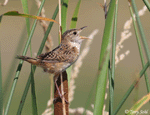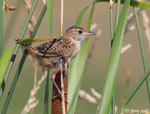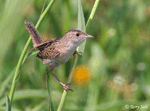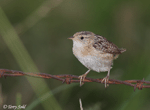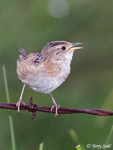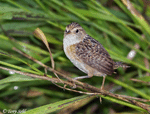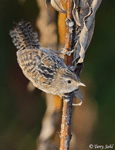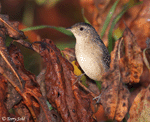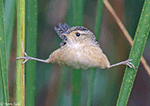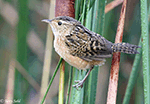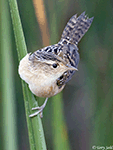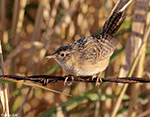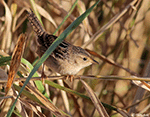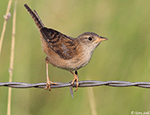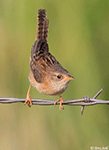| Length: 4.5 inches | Wingspan: 6 inches | Seasonality: Summer / Migrant |
| ID Keys: Brown upperparts with buffy underparts, narrow streaks on crown and back, short bill and tail. | ||
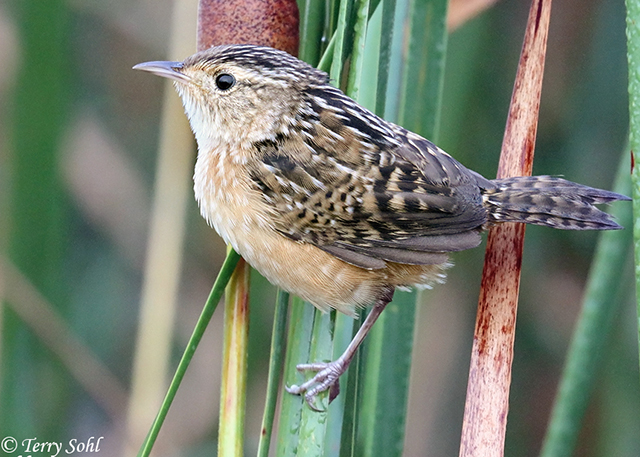 Sedge
Wrens are a shy resident of damp meadows and grasses, generally staying well
hidden in dense vegetation, and only coming into view when singing. The
Marsh Wren is a close relative, but is
normally found in deeper-water marshes than is the Sedge Wren.
Sedge
Wrens are a shy resident of damp meadows and grasses, generally staying well
hidden in dense vegetation, and only coming into view when singing. The
Marsh Wren is a close relative, but is
normally found in deeper-water marshes than is the Sedge Wren.
Sedge Wrens are somewhat nomadic, responding to ephemeral yearly changes in habitat. Their preferences are for wet meadows, and as overall water levels fluctuate in parts of their range, moisture conditions in their preferred habitats fluctuate. Sedge Wrens thus may be present in strong numbers in a given location one year, and gone the next as water levels either rise or fall.
The species has a rather unusual geographic distribution in the Western Hemisphere. Their core breeding area in North America is the Midwest, the Prairie Potholes of the plains region, and areas around the Great Lakes. Birds that breed in North America are migrants, moving to the southeastern US and Mexico for the winter. However, there are scattered, permanent populations in Mexico, Central America, and all the way down to the southern tip of South America. Many of these populations appear to be rather geographically isolated from the nearest other Sedge Wren populations.
Habitat:
Sedge Wrens prefer grassy marshes, wet meadows, and lush grassy fields. They are not found in deeper-water marshes like the Marsh Wren, preferring shallow-water marshes or lush dryland fields. Given the sometimes ephemeral nature of these habitats, populations can thus be nomadic from year to year.
Diet:
Insects and spiders, although exact details of a Sedge Wren's diet are poorly known.
Behavior:
Primarily forages on the ground or very low in the vegetation, clambering around in search of insects. Generally stays well hidden, although males will make themselves quite visible when in song.
Nesting:
June and July in South Dakota. The nest of a sedge wren is a globe of grasses and sedges, lined with down, features, hair, or other fine material. It is placed in grassy vegetation (usually near or in a wet meadow or grassy marshland). Like some other Wrens, the male builds many dummy nests, only completing the one that the female selects. The female lays between 4 and 10 eggs and she alone incubates them. The young fledge from the nest about 2 weeks after hatching.
Song:
Bold staccato notes followed by a rapid trill. They also have a sharp chip call.
- Click here to hear the song of a Sedge Wren1
- Click here to hear the crisp short calls of a Sedge Wren2
Migration:
Neotropical migrant, summering in the Midwest, eastern Great Plains, and south-central Canada. Winters along U.S. Gulf coast and points south. There are many permanent Sedge Wren populations scattered throughout select pockets of Mexico, Central America, and South America.
Interactive eBird Map:
Click here to access an interactive eBird map of Sedge Wren sightings
Similar Species:
Sedge Wrens tend to use a habitat not favored by many other similar looking wren species, but their grassy marshes are often adjacent to cattail marshes populated by Marsh Wrens, or habitats favored by House Wrens.
- Marsh Wren - Both Marsh Wrens and Sedge Wrens can sometimes mingle where their habitats overlap. Marsh Wrens lack the strong patterned streaking on the shoulders and have a more uniformly colored crown than the streaked crown of the Sedge Wren. Marsh Wrens also typically have a strong white eye stripe.
- House Wren - House Wrens are more often found in thickets, shrublands, or forest understory than a Sedge Wren. House Wrens are less strongly patterned than a Sedge Wren, lacking the strong streaking on the back and less strong of a pattern on the shoulders.
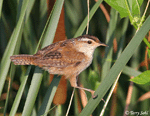 |
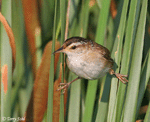 |
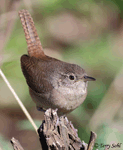 |
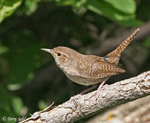 |
| Marsh Wren | Marsh Wren | House Wren | House Wren |
Conservation Status:
Declined in the 19th century and first part of the 20th century, but numbers have been on the increase in the last few decades. They are found over a wide geographic area and are common in some locations. The IUCN thus considers the Sedge Wren to be a species of "Least Concern".
Further Information:
Photo Information:
July 28th, 2006 -- Northwest of Sioux Falls in Minnehaha County -- Terry Sohl
Additional Photos:
Click on the image chips or text links below for additional, higher-resolution Sedge Wren photos.
Audio File Credits:
- 1David Sarkozi. Recorded in Texas on April 18th, 2015. Original recording and information on xeno-canto.
- 2J.R. Rigby. Recorded in Mississippi on November 13th, 2015. Original recording and information on xeno-canto.
| Click on the map below for a higher-resolution view |
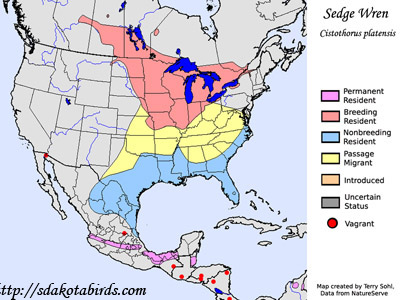 |
| South Dakota Status: Locally common summer breeder in the eastern half of the state. Accidental migrant and summer resident in the west. |
Additional Sedge Wren Photos
Click for a higher-resolution version of these photos
